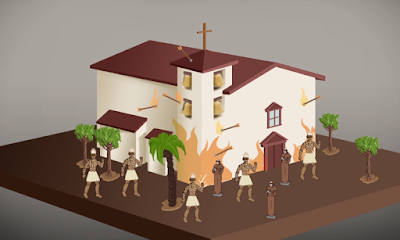I happened to look in my spam folder this morning, and found this cry for help waiting in limbo. I quickly pulled it out and wrote back. Thought I'd post them both here, as it's THAT time of the year and I'm getting a lot of these kinds of notes from frustrated and distraught teachers and parents.
Here's how I responded:
Hi M.,
The comments on that particular post have some good ideas from both parents and teachers.
Here are a few more ideas:
2. An alternative to the mission model might be creating a topographical map of Indian territories in the state, or just in your county (seeing the state filled with Indigenous names and territories is an awe-some experience for Californian kids used to seeing cities and freeways); or a display of photos of Indian baskets, jewelry, clothing over time - it's fun to do a "then and now" comparison, since children often don't realize California Indians today also dress in jeans, Lakers sweatshirts and sunglasses!
3. Try googling for the tribe nearest you and email a contact person to see if they have any members who do classroom visits.
4. A Timeline of California Indian History: By researching the tribes from pre-contact to the present, students learn that many California Indian tribal peoples are still here, still practicing our culture, and human just like them. Many kids think California Indians are all dead - I nearly scared one young girl to death at Mission Dolores once! The visual effect of a long scroll-timeline is powerful, especially if students make it multi-media (photos, maps, charts, drawings): you can wrap it around the room, and students can walk along to see major events - including the arrival of the Spanish, Mexican, and Americans and, most importantly, on into the present - and their research can include often erased facts such as population dives, loss of languages, recuperation of languages, important court cases about land, establishment of California Indian Basket Weavers, California Indian Conference, etc.
5. Simply educating yourself about what the doublespeak on mission websites really means can be helpful. For example, the "monjerio," the room where single Indian women and girls were kept at night, is often explained to children as simply "the women's quarters." The fact that women and girls were LOCKED UP in this room against their wills, that it was dark, smelly, had pits for toilets, was full of germs, and kept little girls away from their mothers at night, is never spoken of. YOU can teach the children how to read critically, question the websites they read, and search for more honest information.
6. I have a letter to 4th graders on my newer blog that might be helpful, too. Feel free to use it. http://badndns.blogspot.com/
Alternatives to 4th grade mission projects tend to take a lot of work, which is partly why it's hard to get educators to change their lesson plans (that, and many simply don't realize that they aren't teaching truthful history - mis-education perpetuating mis-education). There isn't an actual alternative curriculum available yet though several groups are working to get them accepted. For now, focus on learning the truth and translating that is often the best thing you can for your students. Letting them know that there ARE other truths out there is a great first step, especially if you are just realizing what the missions are about and don't have time to plan for this year - there's always next year, and since you are IN California, you can actually layer mini-lessons in all year long.
Many thanks for your concern, and please, let me know if you come up with something new that I can add to my still in-progress list ...
Sincerely,
Note to all: If you have more suggestions, PLEASE write into the comments with them. I'll keep a list and update it for this blog. Also, if any of the curricula in progress have actually been made available, please let me know that too, and sources to give. Many thanks, all.
And I'll leave you with this: "Gabe's 4th Grade Project" - Huwa! Thanks to Vincent Medina and News from Native California.
 |
| Click on photo to see video |


Vincent Medina's piece is amazing! I can totally see the children reading, for instance, "The Indian Testimony" from THE MISSIONS OF CALIFORNIA: A LEGACY OF GENOCIDE (if anyone can find this excellent out-of-print book), and then deconstructing and reconstructing a mission that's a truthful representation.
ReplyDelete